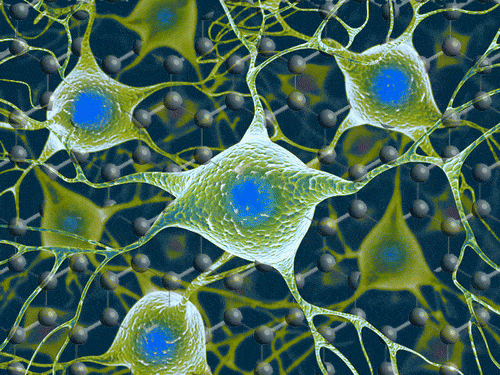Researchers Suggest Implanting Electrodes In Brain To Fight Neural Disorders
Cambridge researchers have demonstrated that the interaction between graphene and neural cells do not harm the integrity of cells. This useful deduction can potentially help to prepare graphene based electrodes capable of restoring sensory functions and healing neural lesions and neurological illnesses like the Parkinson’s disease. The research was a collaborative effort between the University of Trieste in Italy and the Cambridge Graphene Centre. The research was published in the journal ‘ACS Nano’.
The untreated graphene retained its electrical conductivity and showed better signal to noise ratio, when used as an interface. According to Professor Laura Ballerini of the University of Trieste in Italy, untreated graphene has for the first time been used to directly interact with neurons. Later, the electrical pulses generated by neurons were monitored, which showed that the graphene interface coupled with the brain did not alter the electrical signal.

Image Credit: Cambridge press
The advancement of science has significantly improved our understanding of the brain in such a way so that the electrical pulse from a neuron can be controlled to manipulate external systems. Decoded signals can also provide a possible solution to neural diseases.
However, the interaction between neuron and foreign substances has been a complex subject over the years. Silicon or Tungsten electrodes often become unstable and diminish the output electrical signal as insertion of electrodes produce scar tissues, making the movement of electrodes sluggish. Graphene largely erases these problems using its superior conductivity, flexibility, biocompatibility and stability within the body. Experimental results derived from electron microscopy and immunofluorescence on diagnosed rat cells revealed that after the process, the cells remained unharmed.
Researchers believe that pristine graphene-based materials will be the best choice as an electrode for a neuro-interface. Professor Maurizio Prato from the University of Trieste revealed that they were involved in replacing older technologies with graphene based materials in biomedical applications. The research was funded by the Graphene Flagship, a European initiative which promotes a collaborative approach to research with the aim of increasing the usage of graphene based systems in the industry.
A relevant video on brain study of sea animal that might help improve human's neural disorders:
Source: <a href="https://www.cam.ac.uk/research/news/graphene-shown-to-safely-interact-with-neurons-in-the-brain" target="_blank" rel="nofollow noopener noreferrer">Graphene shown to safely interact with neurons in the brain | University of Cambridge</a> | #-Link-Snipped-#
The untreated graphene retained its electrical conductivity and showed better signal to noise ratio, when used as an interface. According to Professor Laura Ballerini of the University of Trieste in Italy, untreated graphene has for the first time been used to directly interact with neurons. Later, the electrical pulses generated by neurons were monitored, which showed that the graphene interface coupled with the brain did not alter the electrical signal.

Image Credit: Cambridge press
The advancement of science has significantly improved our understanding of the brain in such a way so that the electrical pulse from a neuron can be controlled to manipulate external systems. Decoded signals can also provide a possible solution to neural diseases.
However, the interaction between neuron and foreign substances has been a complex subject over the years. Silicon or Tungsten electrodes often become unstable and diminish the output electrical signal as insertion of electrodes produce scar tissues, making the movement of electrodes sluggish. Graphene largely erases these problems using its superior conductivity, flexibility, biocompatibility and stability within the body. Experimental results derived from electron microscopy and immunofluorescence on diagnosed rat cells revealed that after the process, the cells remained unharmed.
Researchers believe that pristine graphene-based materials will be the best choice as an electrode for a neuro-interface. Professor Maurizio Prato from the University of Trieste revealed that they were involved in replacing older technologies with graphene based materials in biomedical applications. The research was funded by the Graphene Flagship, a European initiative which promotes a collaborative approach to research with the aim of increasing the usage of graphene based systems in the industry.
A relevant video on brain study of sea animal that might help improve human's neural disorders:
Source: <a href="https://www.cam.ac.uk/research/news/graphene-shown-to-safely-interact-with-neurons-in-the-brain" target="_blank" rel="nofollow noopener noreferrer">Graphene shown to safely interact with neurons in the brain | University of Cambridge</a> | #-Link-Snipped-#
0
